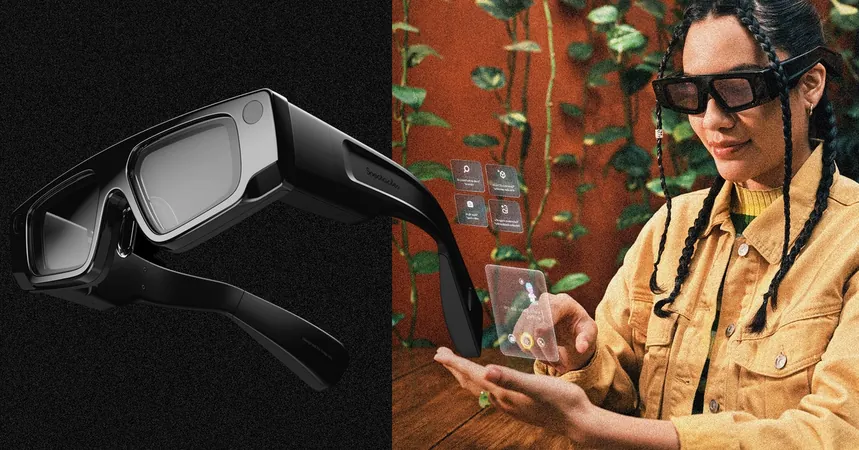
Snap's New AR Spectacles: The Future of Wearable Tech or Just a Temporary Trend?
2024-11-24
Author: Jia
Introduction
Snap Inc. is back in the spotlight with the launch of its latest iterations of augmented reality (AR) glasses, the Snap Spectacles. This new model not only aims to bring users closer to their friends but also hopes to integrate advanced AR features into everyday life. However, there’s a catch: You might not be able to wear them casually just yet.
A Brief History of Snap Spectacles
The journey of Snap’s Spectacles began in 2016 with their first model—vibrantly colored, circular frames designed primarily for taking photos and videos. While they mirrored the fun and rebellious spirit of early social media content, they lacked any AR capabilities. Since then, the company has shifted its focus. In 2021, it revealed a new rectangular design meant to incorporate augmented reality visuals—taking a bold step toward the futuristic style reminiscent of ’80s cyberpunk aesthetics.
The 2024 Edition: A New Challenge
The 2024 edition of these AR glasses maintains this edgy design while softening some of its previous sharp angles. However, there's a significant barrier to entry: the glasses are not fully available for the general public. Instead, interested users must join Snap's developer program for $99 a month, along with a year-long commitment. This could deter casual wearers from shelling out for what is essentially a beta product.
Snap’s Vision for AR
“We’re excited about our latest pair of Spectacles as a step toward our vision of bringing augmented reality to everyone,” said Scott Myers, Snap’s VP of hardware engineering. However, while Snap markets the product towards developers, it’s clear they’re envisioning a broader audience. But will this vision resonate with everyday users who simply want to wear stylish glasses, or will the hefty price and complicated access keep them away?
The Competitive Landscape
The competition is fierce. Shortly after Snap's announcement, Meta introduced its Orion AR glasses, also targeted at developers but with a different form factor. Both products aim to change the way we interact with our environment, but they come with limitations. Snap’s glasses, weighing in at just under half a pound, feature a battery life of 45 minutes—long enough for a short outing but not ideal for extended use.
Performance and Limitations
In testing the new Spectacles, I noted that the display quality is impressive, boasting a resolution of 37 pixels per degree—significantly sharper than Meta’s 13 PPD. Yet, it’s worth noting that the visual field for augmented elements is limited to just 46 degrees, making it feel restricted compared to competitors like the Orion's 70-degree view. This could impede the immersive experience users typically expect from AR devices.
User Interaction and Experience
Voice commands and hand tracking are incorporated into the glasses, allowing users to engage with the augmented reality elements without any physical controllers. However, the varying distances required for gestures may create a learning curve—an added challenge for new users.
Snap's Focus on Social Connectivity
Snap, eager to position itself at the forefront of AR, continues to emphasize social connectivity. With features that allow you to share experiences with friends and explore your surroundings through a unique AR lens, Snap hopes to blend the digital and physical realms. Users can even interact with virtual objects or engage in multiplayer AR games, fostering a sense of community among friends.
Innovative Features: MyAI
An additional feature—MyAI—lets wearers ask questions about their environment using voice commands, enhancing the glasses' capabilities. It's a fascinating concept, but how practical will it be as users navigate crowded streets or busy environments?
Safety and Distraction Concerns
However, there are concerns about safety. Despite Snap's assurances that the glasses will keep users aware of their surroundings, the experience could still lead to distractions, particularly in active environments. Snap needs to establish clear use guidelines to prevent accidents, especially given the potential risks of augmented reality that has previously proven hazardous during gameplay on mobile devices.
The Future of Snap Spectacles
Looking ahead, Snap's Spectacles represent a pivotal moment in the development of AR technology. With the company positioning itself as a pioneer of accessible AR, they have the opportunity to refine the user experience and make significant improvements to the product. By ensuring a lightweight design that’s easy to use and stylish, Snap could transform the Spectacles from developer-only gadgets to everyday tech accessories.
Conclusion
In conclusion, while Snap’s AR Spectacles may not yet reach the mainstream market, they certainly spark intrigue. If they can navigate the hurdles of usability, safety, and widespread appeal, they may just usher in the next era of wearable technology. Only time will tell if these glasses can truly deliver on their promise—will you be ready to wear the future?



 Brasil (PT)
Brasil (PT)
 Canada (EN)
Canada (EN)
 Chile (ES)
Chile (ES)
 España (ES)
España (ES)
 France (FR)
France (FR)
 Hong Kong (EN)
Hong Kong (EN)
 Italia (IT)
Italia (IT)
 日本 (JA)
日本 (JA)
 Magyarország (HU)
Magyarország (HU)
 Norge (NO)
Norge (NO)
 Polska (PL)
Polska (PL)
 Schweiz (DE)
Schweiz (DE)
 Singapore (EN)
Singapore (EN)
 Sverige (SV)
Sverige (SV)
 Suomi (FI)
Suomi (FI)
 Türkiye (TR)
Türkiye (TR)